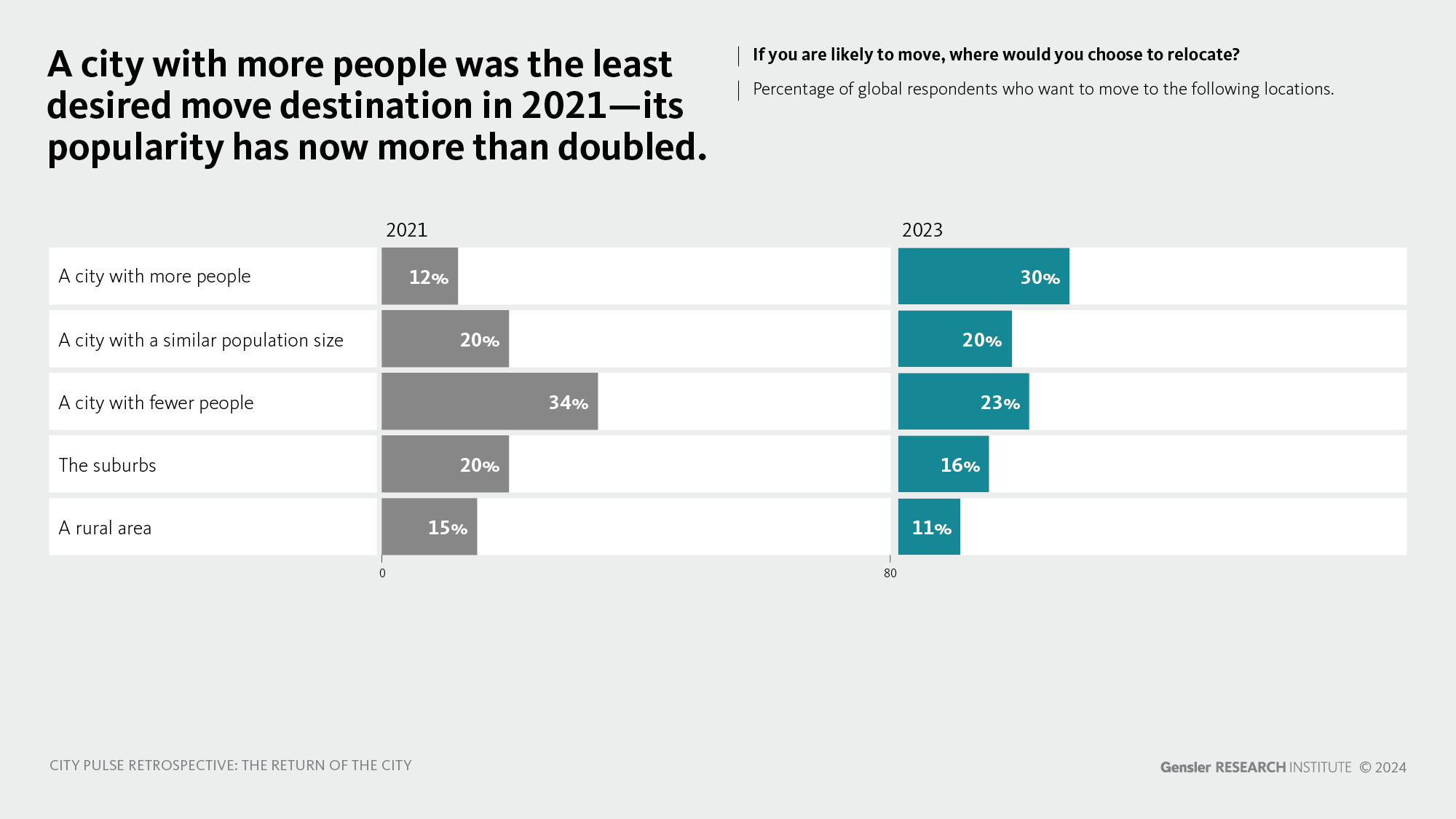Gensler launched its first City Pulse study in 2020 during the first weeks of the global pandemic. In alignment with Gensler’s core mission to make a positive impact in the cities and communities in which we work, and the Gensler Research Institute’s mandate to conduct investigations and collect data in support of these goals, we felt a keen responsibility to research how the public health crisis and resulting lockdowns would affect and influence urban life. As we continued the research into 2021, and while headlines around the world proclaimed the death of cities, we set out to discover what might keep them alive.
This report illustrates how global perceptions have shifted in 15 global cities between 2021 and 2023. We also take a closer look at findings from Austin, San Francisco, New York, London, Mexico City, and Singapore. We examine how some cities that thrived during the pandemic are fighting to maintain their vitality, while other cities that struggled under lockdown are showing signs of resurgence.
A common theme emerges from our data — urban life has pain points, but the desirability of cities is persistent. From the bubonic plague of medieval times to 1918’s Great Influenza, pandemics have catalyzed urban reinvention. Our research shows that we are once again at that pivotal historical moment: the return of the city.

Density is a draw again — urban residents want to move to cities with more people.
More people want to move today than in 2021, and where they want to move has changed. Fewer respondents want to move to the suburbs or rural areas, and 73% percent of those who want to move intend to relocate to a city of some kind. The most popular destination is a city with more people, indicating that the draw of density has rebounded after a time marked by social distancing. History shows us that cities rebound after pandemics — and the public health crisis of recent years looks to be no exception.

Two-thirds of urban residents say that their neighborhoods feel authentic, beautiful, clean, and welcoming.
At the start of the COVID-19 pandemic, levels of neighborhood isolation intensified as cities around the world went into lockdown. Rates of violence and crime increased in many neighborhoods — particularly those that were already socioeconomically disadvantaged or marginalized. Our data indicates that some of these concerns are receding — residents of the 15 cities profiled in this data felt more positively about their neighborhoods and cities in our recent 2023 city pulse data than they did in 2021. More people think that their neighborhoods feel authentic (66% in 2023 vs. 60% in 2021), beautiful (67% in 2023 vs. 59% in 2021), clean (65% in 2023 vs. 60% in 2021), and welcoming (63% in 2023 vs. 55% in 2021). More respondents (60% in 2023 vs. 52% in 2021) also feel that their neighborhoods offer multigenerational housing options. Additionally, 49% of urban residents feel that their neighborhoods prioritize pedestrians over cars (compared to 40% in 2021).

When it comes to city life, urban residents are more optimistic and engaged.
Optimism for the future of cities has improved by 14% points — one of the largest response increases in the entire study. Optimism is particularly high among younger residents. 70% of Millennial respondents (a 14% increase from 2021) and 62% of Gen Z respondents (an 18% increase) report feeling positively about their city’s future. Additionally, urban residents are also more engaged. 35% of respondents say they participate in community planning decisions, compared to 24% in 2021. This shows that the allure of cities — and the opportunities for connection, culture, and career advancement that they bring — remains strong, and will likely continue to grow stronger in the years to come.
City Pulse Methodology
Two anonymous, panel-based surveys focused on the future of centralized business districts were conducted online from September 7 to October 15, 2021 and from May 1 to June 18, 2023. The 2021 survey included 7,500 urban residents across 15 cities and the 2023 survey included 26,000 urban residents across 53 cities. Respondents were required to live within the city administrative boundaries, with the exception of Los Angeles — where residents were required to live within the county administrative boundaries. Respondents were demographically diverse across gender, age (18+), income, and education levels. This report focuses on the 15 cities included in both surveys: Atlanta, Austin, Charlotte, Chicago, Denver, London, Los Angeles, Mexico City, New York, Paris, San Francisco, Seattle, Shanghai, Singapore, and Toronto.
Download The Return of the City: A 2024 Retrospective of the City Pulse report to learn how global perceptions have shifted in 15 global cities between 2021 and 2023.